|
Tune Into Old Radios
by Bob Brooke
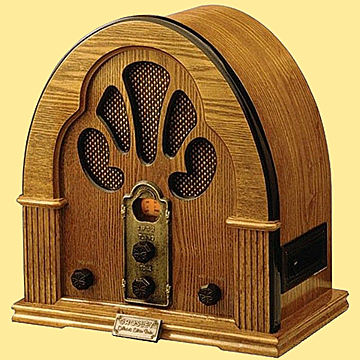 Radios
have been an essential part of life for nearly a century. When they
first appeared, they literally opened up the world for thousands of
people. Like many collectibles, radios offer a piece of nostalgia. In
their heyday, they were the primary source of home entertainment,
delivering music, drama, news and even soap operas to people's living
rooms. The radio also gave birth to many famous names including Jack
Benny and The Lone Ranger. And it was radio that brought about near
panic with Orson Welles’ 1938 broadcast of the H.G. Wells drama, "War of
the Worlds." Radios
have been an essential part of life for nearly a century. When they
first appeared, they literally opened up the world for thousands of
people. Like many collectibles, radios offer a piece of nostalgia. In
their heyday, they were the primary source of home entertainment,
delivering music, drama, news and even soap operas to people's living
rooms. The radio also gave birth to many famous names including Jack
Benny and The Lone Ranger. And it was radio that brought about near
panic with Orson Welles’ 1938 broadcast of the H.G. Wells drama, "War of
the Worlds."
Radios attract collectors fascinated with this early, primitive
technology. Some buy old radios to accent Art Deco interiors. Some buy
them from a particular period while others collect radios made by a
specific company. And some even collect radio parts, such as tubes and
knobs.
A Brief History of Radio
Although radio transmission had been possible as early as 1865, it
wasn’t until 1927, with the introduction of the radio tube and AC power
that radio became convenient and widely available. By 1940, just about
every home and even some cars had a radio.
Nikola Tesla demonstrated the transmission and radiation of radio
frequency energy in 1892, proposing that it might be used for the
telecommunication of information. In 1895, Guglielmo Marconi built a
wireless system capable of transmitting signals at long distances and
demonstrated that radio could be used in commercial, military and marine
communications. In 1901, Marconi conducted the first successful
transatlantic radio communications. The U.S. Patent Office awarded
Marconi a patent for the invention of radio in 1904.
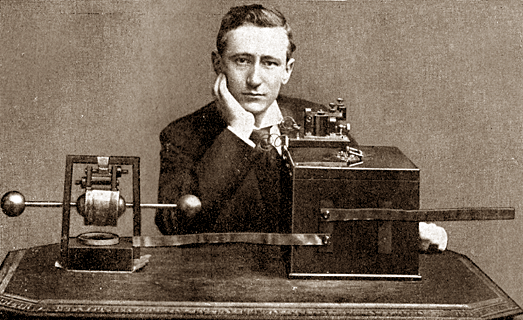
Reginald Fessenden and Lee de Forest invented amplitude-modulated or AM
radio which enabled more than one station to send signals at the same
time. On Christmas Eve 1906, Fessenden made the first radio audio
broadcast from Brant Rock, Massachusetts.
On March 8, 1916, Harold Power conducted the first continuous broadcast,
lasting three hours, from Tufts University under the call sign 1XE. The
company later became the first to broadcast on a daily schedule, and the
first to broadcast radio dance programs, university professor lectures,
the weather, and bedtime stories.
Edwin Howard Armstrong patented three important inventions that made
today's radio possible— regeneration, the superheterodyne circuit, and
wide-band frequency modulation or FM. Regeneration or the use of
positive feedback greatly increased the amplitude of received radio
signals to the point where they could be heard without headphones. FM
gave listeners a static-free experience with better sound quality and
fidelity than AM. In October 1920, radio station KDKA in Pittsburgh,
Pennsylvania, received its license and became the first U.S. licensed
commercial broadcasting station.
Old Radio Styles
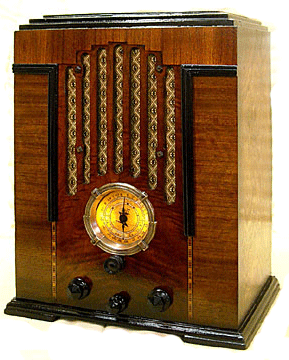 When
most people think about radio collecting, they probably picture the
"tombstone" style radio with its vertical rectangular shape. The
cathedral is another popular style, but its case is pointed or rounded
on top. Radios come in a variety of styles and manufacturers employed a
variety of materials including wood and several kinds of plastic to make
them. When
most people think about radio collecting, they probably picture the
"tombstone" style radio with its vertical rectangular shape. The
cathedral is another popular style, but its case is pointed or rounded
on top. Radios come in a variety of styles and manufacturers employed a
variety of materials including wood and several kinds of plastic to make
them.
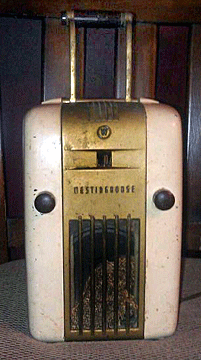 Many
collections contain a variety of radios. One of the most interesting is
the 1948 Westinghouse Little Jewel, made in the shape of a refrigerator
and given away with the purchase of one. They came in different colors,
to match the refrigerator purchased by the customer. Today, they’re
selling for about $150. Many
collections contain a variety of radios. One of the most interesting is
the 1948 Westinghouse Little Jewel, made in the shape of a refrigerator
and given away with the purchase of one. They came in different colors,
to match the refrigerator purchased by the customer. Today, they’re
selling for about $150.
In the 1930s, many radio makers began using Plaskon or Catalin, both
early types of plastic. Among the cheapest available at the time,
they’re now among the most desirable and most expensive to collect. .
Certain Catalin radios in excellent condition can be quite costly
because Catalin was very brittle and cracked easily.
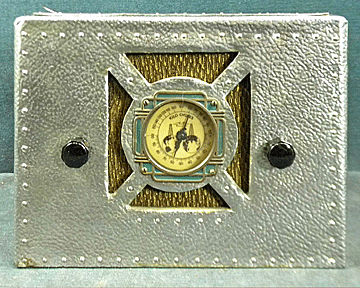 Radios
with chrome-plated chassis are also popular with collectors. The price
of a 1941 Scott Laureate chrome chassis radio compared to the price of a
Dusenburg car. Only wealthy people could afford them since they cost as
much as $1,000. These were among the first high- performance radios,
with some models containing as many as 30 tubes. Radios
with chrome-plated chassis are also popular with collectors. The price
of a 1941 Scott Laureate chrome chassis radio compared to the price of a
Dusenburg car. Only wealthy people could afford them since they cost as
much as $1,000. These were among the first high- performance radios,
with some models containing as many as 30 tubes.
The development of the transistor allowed manufacturers to create
novelty radios like the 1956 Crosley transistor radio, designed to look
like a book, entitled "Enchantment,"
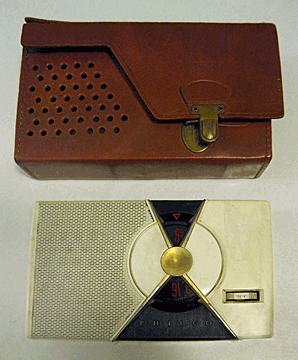 "Musical
Memories," or "Treasure Island." These now sell for about $95. There are
also radios in the shape of a Coca-Cola can and even a toilet.
Transistor radios like the Zenith Royal 500B, made in 1959 and popularly
known as “Owl Eyes,” tend to be more popular with younger collectors. "Musical
Memories," or "Treasure Island." These now sell for about $95. There are
also radios in the shape of a Coca-Cola can and even a toilet.
Transistor radios like the Zenith Royal 500B, made in 1959 and popularly
known as “Owl Eyes,” tend to be more popular with younger collectors.
Hundreds of manufacturers. including RCA, Zenith, and Philco, produced
radios. Other names familiar to collectors include Atwater Kent, Arvin,
Fada, Bendix, Emerson and Magnavox. There were also companies who made
only a small number of radios, such as Maco and Revere.
How to Tell the Age of an Old Radio
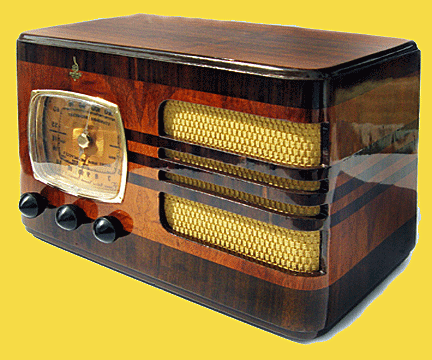 Dials
and tube styles both provide clues to a radio's age. Makers installed
small window dials in their radios in the early 1930s. Radios sported
larger, round dials by the mid 1930s. But the familiar rectangular dial,
known as a slide rule dial, didn’t appear until the late 1930s. Dials
and tube styles both provide clues to a radio's age. Makers installed
small window dials in their radios in the early 1930s. Radios sported
larger, round dials by the mid 1930s. But the familiar rectangular dial,
known as a slide rule dial, didn’t appear until the late 1930s.
A look at the tubes inside an old radio will also provide clues to its
age. From the late 1920s to the mid 1930s, tube bases had four to six
pins. The tubes from the mid 1930s have eight pins and a plastic center
key. Some metal may also cover the glass. Tubes dating from the 1940s to
1950s are generally smaller than their older counterparts and have seven
to nine pins.
Restoring Old Radios
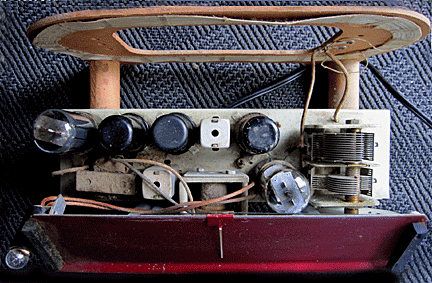 Radio
collecting is for people who like to fix old machines. Because people
used radios heavily, restoration is as much a part of the collecting
process as purchasing a radio. It's better for collectors to fix their
own radios than send them for expensive professional repairs. One of the
attractions to radio collecting is that buyers can still find the parts
necessary to fix them. While most radios can be fixed, finding the old
tubes is getting more difficult. A good how-to book, a voltmeter, and
some experience and knowledge about the workings of these old machines
are the main tools a collector needs to restore old radios. Radio
collecting is for people who like to fix old machines. Because people
used radios heavily, restoration is as much a part of the collecting
process as purchasing a radio. It's better for collectors to fix their
own radios than send them for expensive professional repairs. One of the
attractions to radio collecting is that buyers can still find the parts
necessary to fix them. While most radios can be fixed, finding the old
tubes is getting more difficult. A good how-to book, a voltmeter, and
some experience and knowledge about the workings of these old machines
are the main tools a collector needs to restore old radios.
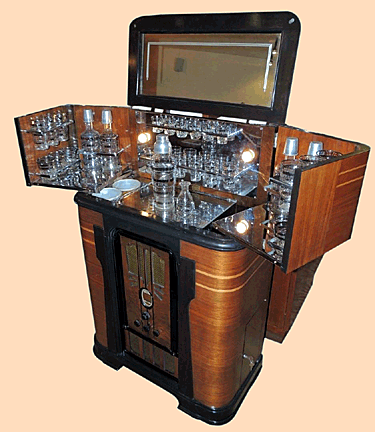 But
getting an old radio to work is only half the problem. Many are in
desperate need of restoration. Paint may have to be removed before the
original cracked and buckled veneer can be replaced. To restore wooden
radio cabinets, a collector needs a sander, veneer salvaged from the
cabinet of a junk radio, glue, varnish, and a number of woodworking
tools. But
getting an old radio to work is only half the problem. Many are in
desperate need of restoration. Paint may have to be removed before the
original cracked and buckled veneer can be replaced. To restore wooden
radio cabinets, a collector needs a sander, veneer salvaged from the
cabinet of a junk radio, glue, varnish, and a number of woodworking
tools.
How Much is it Worth?
While some old radios sell for a considerable amount of money, most are
reasonably priced. For example, a 1947 General Electric 180 table radio,
made of wood with a right-hand dial and a cloth grill with horizontal
knobs, lists for $30. A 1936 RCA 5T1 wood tombstone with a center dial,
upper cloth grill with cut-outs and a tuning eye sells for $150. A 1940
Zenith 6-D455 wooden bookcase radio with an inner dial and controls,
fold-down front and two lower shelves, lists for $200. The Zenith Royal
300, marked tubeless and made in 1959, which sold for $80 new, now sells
for $75 to $150 while the Zenith Royal 500B, made in 1966, sells for
about $75. On the more expensive side is the Fada Catalin Model 1000,
Bullet Deco Radio, selling for $2,250. Some radios even come with their
original instructions.
< Back
to Collectibles Archives
Next
Article >
|
